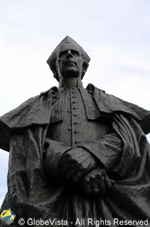Archbishop Daniel Mannix statue

Public Art : Archbishop Daniel Mannix statue
Sculptor: © Nigel Boonham
Description: This is a larger than life 9ft bronze sculpture of Daniel Mannix (4th of March 1864 – 6th of November 1963) , Melbourne’s Catholic Archbishop from 1917 until his death in 1963.The Archbishop is depicted in full Catholic including a cassock , mozzetta (cape) mitre (headdress ). If you look carefully on his right hand he is wearing the Fisherman’s ring. Surprisingly , there is no cross featured in the sculpture. I don’t think it was by accident that the statue of the “politically vocal” Archbishop (with hands clasped in front clutching his cape) was placed to overlook the Victorian Parliament.
Date Unveiled: The statue of Archbishop Mannix was unveiled in March, 1999.
Location: The Archbishop is located in the forecourt of St Patrick’s Cathedral, Melbourne, Australia.
Things You May Not Know About Daniel Mannix:
Daniel Mannix, was born in Charleville, County Cork, Ireland on March the 4th, 1864. He studied at St. Patrick’s College, Maynooth, County Kildare where he was ordained a priest in 1890.
He arrived in Melbourne 1913 as coadjutor archbishop and become archbishop of Melbourne in 1917.
Mannix was extremely vocal about politics and popular cultural issues , something the church had traditionally side stepped. He was basically pro Irish and anti British, with a vision of Australia breaking free of the shackles of the Empire. Surprisingly, this did not make him very popular in certain circles.
Mannix, who had just become the newly appointed Catholic Archbishop of Melbourne led the fight against Australian conscription during the First World War . This did not go down well with the then Prime Minister Billy Hughes. In an article published in a Christian magazine at the time called Australia he said “that if the war had been in the hands of the [Australian] people, there would have been no war”. It could be argued that Mannix’s actions and vocal objections during this time lead to the swaying of public opinion against the celebration of “Empire Day”. Which was established to not only celebrate the birthday of Queen Victoria but basically all things British.
Mannix said during an interview in 1962 that he “only finally decided to speak out in favour of voluntary enlistment after he heard the Anglican Archbishop of Melbourne speak from the pulpit of St Paul’s about the need for conscription.”
He demanded state aid for education of Roman Catholics in return for their taxes.
In 1920, due to his zealous support of Irish Independence, the British Government prevented him from landing in Ireland during a official journey to Rome.
After World War II he campaigned to stop Communist infiltration of the Australian trade unions and played a role in the dissensions within the Australian Labor Party during that time. He also backed the largely right-wing Catholic Democratic Labor Party.
Mannix described himself as a pacifist in the “real sense” and stood with Prime Mister Menzies in condemning war. He believed the First and Second wars were simply “trade wars” .
To avoid conflict within the church, Mannix would often argue that his anti-Empire comments and actions were as an Australian citizen participating in public debate and not as a member of the Catholic Church. .
Mannix was strongly opposed to the ideal of Australians being a “British” people and was a strong advocate against the “White Australian Policy, which encouraged only those of European decent (basically British) to migrate to Australia. He saw this as “crude” and believed Australians had a lot to learn from other races, stating in 1962 “there is no colour bar in Australia”
In his lifetime Archbishop Mannix established 181 schools, including Newman College and St. Mary’s College at the University of Melbourne, and 108 parishes.